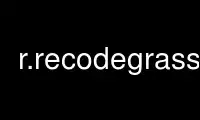
This is the command r.recodegrass that can be run in the OnWorks free hosting provider using one of our multiple free online workstations such as Ubuntu Online, Fedora Online, Windows online emulator or MAC OS online emulator
PROGRAM:
NAME
r.recode - Recodes categorical raster maps.
KEYWORDS
raster, recode categories
SYNOPSIS
r.recode
r.recode --help
r.recode [-ad] input=name output=name rules=name [title=string] [--overwrite] [--help]
[--verbose] [--quiet] [--ui]
Flags:
-a
Align the current region to the input raster map
-d
Force output to ’double’ raster map type (DCELL)
--overwrite
Allow output files to overwrite existing files
--help
Print usage summary
--verbose
Verbose module output
--quiet
Quiet module output
--ui
Force launching GUI dialog
Parameters:
input=name [required]
Name of raster map to be recoded
output=name [required]
Name for output raster map
rules=name [required]
File containing recode rules
’-’ for standard input
title=string
Title for output raster map
DESCRIPTION
r.recode creates an output raster map by recoding input raster map based on recode rules.
A title for the output raster map may be (optionally) specified by the user.
The recode rules can be read from standard input (i.e., from the keyboard, redirected from
a file, or piped through another program) by entering rules=-.
Rules are defined in one of these formats:
old_low:old_high:new_low:new_high
old_low:old_high:new_val (i.e. new_high == new_low)
*:old_val:new_val (interval [inf, old_val])
old_val:*:new_val (interval [old_val, inf])
r.recode is loosely based on r.reclass and uses the GRASS Reclass Library to convert the
rasters. It has routines for converting to every possible combination of raster (eg. CELL
to DCELL, DCELL to FCELL, etc). Standard floating point raster precision is float (FCELL),
with -d double precision (DCELL) will be written.
There are four basic routines that it accepts:
1 old-low to old-high is reclassed to new-low to new high , where the user provides
all four values. The program figures on the fly what type of raster should be
created.
2 old-low to old-high is reclassed to a single new value. Anything outside the range
is null.
3 * to old-high will reclass everything less than old-high to a single new value.
4 old-low to * will reclass everything greater than old-low to a single new value.
These four sets of arguments can be given on the command line, or piped via stdin or a
file. More than one set of arguments is accepted.
EXAMPLES
Map type conversion
To simply convert a raster between formats (eg. int to float) the user would use the first
argument. For example
10:1500:0.1:15.0
would convert an input raster map with range between 10 and 1500 to a float raster raster
with range bewteen 0.1 and 15.0.
Value replacement
r.recode can be used to replace existing cell values by others. The formatting is as
described above. In following example the values 1, 2 and 3 are replaced by 1.1, 7.5 resp.
0.4:
r.recode input=oldmap output=newmap rules=- << EOF
1:1:1.1:1.1
2:2:7.5:7.5
3:3:0.4:0.4
EOF
Use r.recodegrass online using onworks.net services
